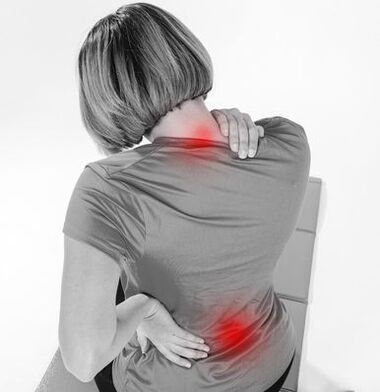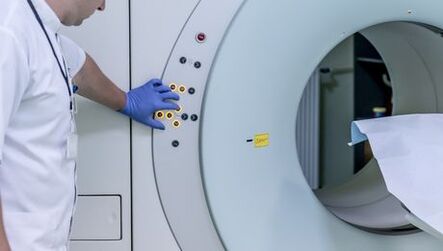
Do you feel the pain in your back and numbness?These are the first signs of osteochondrosis.Inadequate lifestyle mobility, sitting work, neck load and spine leads to the fact that the cartilage tires and loses moisture as a result of which they are damaged.
With cervical osteochondrosis, degenerative changes occur in the intervertebral discs.Not only do the discs undergo damage, but also the beads and joints in the cervical region.If you do not treat the disease for a long time, the patient's overall health worsens: persistent headaches, vertebrates, deterioration in cerebral circulation, as a result of which cognitive functions are reduced.
Reasons for developing osteochondrosis
An incorrect sitting position, in which the neck extends forward leads to the development of a cervical disease.In this case, excess pressure on the intervertebral discs occurs, which leads to changes in the pulposus nucleus and squeezing blood vessels.This position is that a person occupies the workplace in front of the computer.Therefore, office employees are most often subject to the development of cervical back osteochondrosis.

Moreover, the causes of pathology development can be:
- Improper distribution of load when wearing bags;
- a very mild place of sleep (spine is bent in an unnatural shape);
- genetic predisposition;
- Lack of vitamins and trace elements in the diet;
- Endocrine system disorders;
- curvature of the spine and violation of attitude during active body growth;
- cervical vertebrae damage;
- The presence of bad habits.
The stages of the disease
To determine whether your pain symptoms are signs of the development of cervical spine osteochondrosis and which stage of development of the disease can only be determined by an experienced physician after examination and palpation.In total, cervical osteochondrosis passes four stages of development:
- Nucleus pulposus - the central part of the intervertebral disc in the first stage is subject to moderate dehydration.As a result, the supporting and shocking functions of the intervertebral drive shock are gradually lost.In the first stage, you will experience pain with unexpected movements, hypothermia and stay in a position for a long time.
- The second stage of development is characterized by the emergence of stale phenomena and spasms that squeeze capillaries and blood vessels, preventing normal blood circulation.As a result, the frame of the intervertebral disc is thinner, forming the proportion (extended forward or backward).Under the influence of excess load on the cervical vertebrae, osteophytes are formed.The pain sensations are located in one place, with sharp curves and sloping of the head, there may be displacement of the cervical vertebrae.
- Extraction is formed as a result of the thinning of the intervertebral discs.The edge of the pulposal core breaks the fibrous ring and goes beyond the ends of the vertebral body.The muscles and nerve endings are squeezed.It is felt by the pain in the neck, spine and limbs.
- In the fourth stage of the disease, the intervertebral discs are displaced and formed by central and lateral hernia.Moreover, wounds form on discs, which leads to the stationary of the affected joint.The patient experiences persistent back pain, which is given to other parts of the body, a constant feeling of fatigue occurs, the asymmetry of the luggage occurs occurs.

Symptoms of cervical osteochondrosis
Symptoms of osteochondrosis of the cervical spine manifest differently depending on the stage of development of the pathology.In the early stages, it can occur practically without the presence of signs.Pain in the neck and spine can only occur in case of prolonged stay in a position, sharp trend or twist.
In the later stages of development, a cramp is heard in the back, the back pain is given to other limbs, there is a numbness of the body parts.With the formation of osteophytes and extraction, there are:
- headaches in the back of the head and parietal part;
- impaired speech and numbness of language;
- decrease in neck skin sensitivity;
- respiratory disorders;
- Oath for blood pressure;
- heartbeat disorders;
- noise and stagnation in the ear;
- Fainting.
Symptoms of cervical spine osteochondrosis in women are much more pronounced than in men.This is due to the fact that women have a predisposition to vascular diseases and a more fragile structure of spinal bone segments.Signs of the disease begin to appear when the intervertebral disk appears.This leads to a violation of normal blood circulation and causes severe headaches, dizziness and neurosis.An irritation of the disease in women often occurs during menopause, when the body undergoes changes on a hormonal background.
Symptoms of cervical osteochondrosis in men are similar to female dysfunction, erectile can be observed separately.
Headache for cervical osteochondrosis is caused by blood circulation disorders and spinal cord.When the beads move, they squeeze the arteries, and the oxygen content in the blood decreases.Unfortunately, such pain may not pass even after receiving strong sedatives.Therefore, it is important to approach the problem solving in a comprehensive way.Dizziness for cervical osteochondrosis can be associated with darkening in the eye, the appearance of noise in the ears.This is because spasical muscles cause a decrease in oxygen entry into the brain.
A lump in the throat with osteochondrosis of the cervical spine, as well as burns, difficulty breathing and abdominal muscle aches - this is a common occurrence.The disease provokes squeezing of the nerve fibers of the cervical back on the head and neck.Disordishes nerve impulses cause sore throat.
Due to blood vessel spasms and irritation of the nerve endings, jumps occur in blood pressure.Increased lower pressure in osteochondrosis indicates that blood supply in individual areas of the brain is disturbed, as vertebral artery survives from the intervertebral discs.As a result, oxygen hunger occurs and blood pressure increases.

How is the diagnosis of osteochondrosis of the cervical spinal osteochondrosis?
The diagnosis of pathology begins with a specialized consultation.In the first manifestations of osteochondrosis, contact the rheumatologist, neuropathologist, surgeon or traumatologist.The doctor will ask about the symptoms and frequency of their manifestation, it is necessary to provide the specialist with the full history of the disease and the results of early studies (if any).The specialist will carry out a visual inspection and palpation, direct him for tests.The doctor during the examination pays special attention to the mobility of the neck, muscle tone, skin sensitivity and detects the most painful areas.
To identify the condition of the muscles, ligaments, blood vessels, to detect inflammatory processes or tumors, an informative and safe diagnostic method - MRI of the cervical spine has been described.The patient during osteochondrosis MRI stands on a special table attracted to the back.The roles are placed on the head to the patient to remove the muscle tension, and the limbs are fixed with belts.Love every insignificant movement during the procedure can affect the quality of the result.Next, the table stops at the tomograph.The procedure does not cause pain.Tomography makes a heavy noise during scanning, so you can use headphones so that you do not feel discomfort.
If MRI is contraindicated, there are other diagnostic methods such as calculated tomography and radiography.X -Ray is only suitable for the primary diagnosis and does not give an image of the layer -in layers of affected tissue.However, this study is simpler and more economical, which allows you to explore the patient's body in several projections.Due to the strong burden of radiation in the body, radiography cannot be performed often.
During calculated tomography, scanning is performed using one or more packs of ionizing rays.They pass through the human body and are recorded by detectors.Detectors move along the patient's body in opposite directions and are fixed to 6 million signals.Different tissue density with an accurate determination of the boundaries of the organs and areas affected in the form of a section appear in the figure.The procedure allows you to get a layered image.

Treatment of cervical back osteochondrosis
How to treat cervical osteochondrosis, only one doctor will determine after examination, study of medical history, and obtaining hardware diagnosis results.If the disease was diagnosed at an early stage, then treatment will be subject to conservative ways.In the treatment of osteochondrosis, it is important to adhere to an integrated approach - take medication, get involved in physiotherapy, go to therapeutic massage, and avoid severe physical exercise.
First of all, you need to stop the pain.For this, analgesics and painkillers of local action are described.With strong muscle cramps, they are prescribed to wear an orthopedic collar.Once the pain syndrome is eliminated, it is necessary to stop the inflammatory process and restore normal blood circulation.For this, antioxidant, anti -inflammatory therapy is performed.Extra measures, therapeutic, swimming exercises have been described.You can engage in physical education both at home and a coach.
If osteochondrosis has become severe, the doctor may prescribe surgical intervention.Surgery is directed in rare cases when the pathology develops against the backdrop of other diseases - scoliosis, intervertebral disc herniation, bending or displacement of the spine, damage.
The treatment of cervical osteochondrosis in women is not particularly different from the treatment of men.However, doctors often recommend women to make external compresses to heat and strengthen the neck muscles.
Experts recommend that from early childhood prevent various back diseases.To do this, you need to form the right behavior while walking and staying on the desktop.Complete nutrition and proper strengthening of the back muscles will help to avoid negative consequences in the future.



































